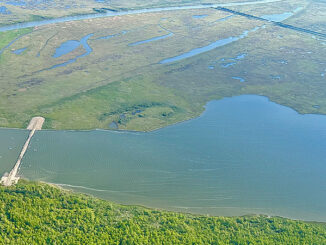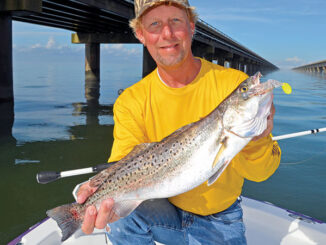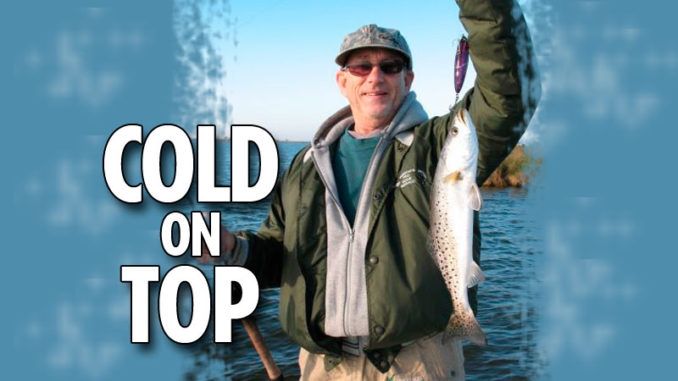
When the sane folks gang up around deep holes in Pointe-aux-Chene’s sulphur mine, this fishing guide heads to the shallows to catch topwater trout.
Yogi Berra is credited with saying, “It’s like deja’ vu, all over again,” which was precisely what I was thinking on a recent frigid morning as I stepped into the parking lot at Basson’s Boat Launch in Galliano. The air temperature gauge on my truck read 38 degrees when we left that morning, but it was predicted to warm up into the mid 50s. I had arranged a trip to fish with charter Capt. Gordon Matherne (985-758-2824), and we got in line behind several others waiting to launch. I mentioned that it was hard to believe so many people were fishing on such a damp, grey and miserable day, but Matherne said the Sulphur Mine can produce some great fishing in the deeper water on days like this one.
Problem was, we weren’t going to be fishing in the deeper waters, like the sane people.
We were heading for the shallow flats to toss topwater baits.
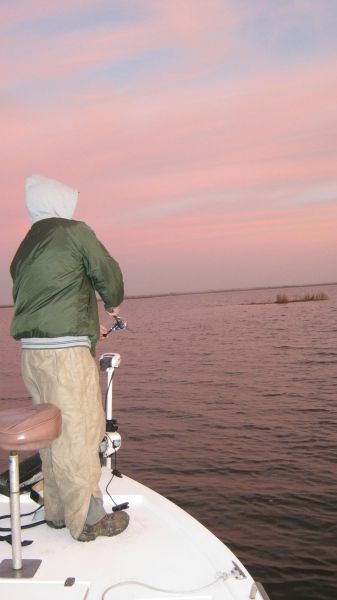
It’s a favorite tactic of Matherne’s this time of year, and one that I’d done with him a few years ago quite successfully; hence, the deja’ vu feeling.
“Normally you’d want to launch here and either fish right over there, 50 yards out from the launch where the fish tend to congregate in this dead-end area, or you make the 10-minute ride directly to the Sulfur Mine,” Matherne said. “It’s a pretty big area, and there will be a lot of boats in there, fishing the bottom over the deeper holes.
“Way back before Hurricane Katrina, there were holes 30 to 50 feet deep in there, but those holes are now gone, buried under silt. It averages about 7 feet deep now, with the deepest hole about 12 feet, which is still plenty deep enough to attract and hold trout and redfish when it gets cold, which in turn, attracts all these fishermen.”
But, to be frank, Matherne isn’t your average angler, and he doesn’t always do “normal.”
For instance, Matherne is a very well-known bug catcher in his Bayou Gauche hometown. He’s collected insects since childhood, and for the past several years has led numerous forays into swamps and wetlands to collect bugs for the Audubon Insectarium and the Butterfly Garden.
He’s led swamp excursions for National Geographic Magazine and TV and for the Discovery Channel, and when the Walt Disney Film production crew was in town and needed 50 frisky bullfrogs for the premier of their musical animation, The Princess and the Frog, it was Matherne they called for the task.
I’ve seen him chase down nutria in an airboat and snatch them up by the tail, and reach out to pet a 12-foot alligator on the head in the wild and a 20-foot whale shark off the back of a boat.
So “normal” isn’t the word I’d use here.
On this abnormal morning, he backed his 22-foot Blazer Bay down the ramp, and we headed to the shallows to fish with topwater baits.
I knew three things before we started: I knew it was going to be cold, and I knew we wouldn’t catch a ton of fish, but I also knew we’d catch some fish.
“The topwater action is best when the air and water temperatures are at least in the mid-50 (degree) range,” he said, “and despite the early cold, we should have that today. “
Topwater baits will generally attract larger fish, but not as many fish. You can also catch plenty of small trout on the baits because a trout can open its mouth almost as wide as its body and swallow a fish about half its size.
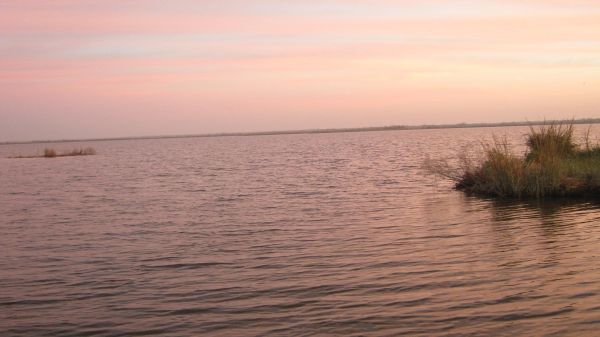
But the dangling treble hooks will snag the side of their mouths and generally prevent them from swallowing it. That’s why most hook-ups are in the lip area and the trout will shake their head violently to dislodge the bait.
Less than five minutes from the launch, Matherne turned the boat into a shallow section of marsh and dropped the trolling motor over the bow. He trolled toward a narrow spit of marsh where some current was moving, and we began the usual cast and walk-the-dog topwater retrieve.
We both were tossing Bomber Badonk-A-Donk lures in the speckled trout color, which he said had been producing some good hits on his last couple trips. Matherne said the mullet- or speckled trout-colored lures were consistently the best performers, especially in the early mornings or on cloudy, overcast days.
Our initial casts didn’t generate any strikes, but after 10 minutes or so of casting we had a couple of hits and misses, indicating the trout were warming up enough to begin to forage.
“Those were smaller fish, judging by the splash and bump,” Matherne said. “That’s not the ones we’re looking for, but at least we know there’s some fish in here and they’ll hit our baits this morning.”
 Our intended prey were the bigger fish that will roam around grass islands and points with some water movement. Naturally we didn’t expect the big spring and summer mules, but winter trout can be sizeable, and 3 pound fish are not that uncommon.
Our intended prey were the bigger fish that will roam around grass islands and points with some water movement. Naturally we didn’t expect the big spring and summer mules, but winter trout can be sizeable, and 3 pound fish are not that uncommon.
What to look for
Matherne said the ideal situation for February topwater action is to choose a day when the water and air temperature will hit the mid-50s.
“You can catch them on topwater baits in colder weather, but the bite tends to be slow,” he said.
You also want to pick a day with some good tidal range.
“A foot of range is ideal, and the premium bite is on a falling tide,” he said. “You can catch them with a little less or a little more range, and they will hit pretty good on a rising tide, but falling is best.”
Matherne said another key to February success is to look for schools of mullet, usually visible on the surface.
“Shrimp get scarce in the winter months, and the trout will primarily feed on baitfish from now until spring,” he said. “That means you’ll want to ‘match the hatch’ and fish with a lure that resembles what they’re feeding on. And small mullet will be a primary food source for both trout and redfish this month, so wherever you find them schooled up you’ll want to fish there.
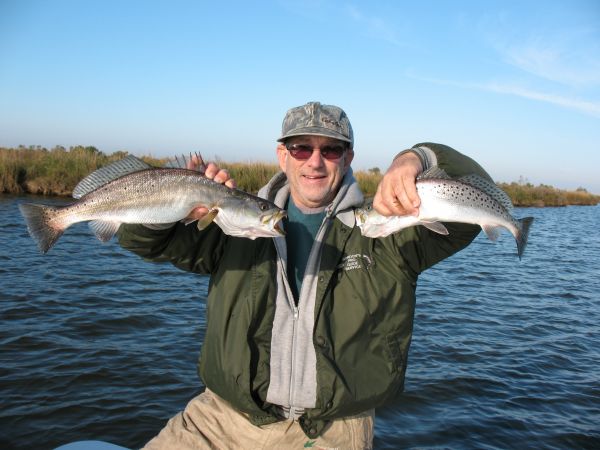
“And fish an open pond, with about 2 feet of water, and fish a protected shoreline, out of the wind. The wind blowing up against the shoreline makes waves and stirs up the bottom, and that will obscure your bait from the fish’s vision. With topwater fishing you want them to be able to see the bait on the surface, see it moving and hear it splashing, which sounds like a baitfish in distress. That’s like a dinner bell ringing to a hungry trout or red.
“Waves splashing will drown out the sound of your topwater bait, and it also makes your bait harder to see. Which brings up perhaps the most important point of all; you have to find clear water, the clearer the better. Don’t waste your time topwater fishing in cloudy water.”
We continued to troll through a series of connected shallow ponds, and at no time did the depth rise above 2 ½ feet on the sonar.
We continued to attract attention with our floating baits, and boated several keeper-sized trout — but none in the size range we were seeking.
I saw several boaters whizz past on their way to the deep water of the Sulfur Mine, looking quizzically at us in the shallows on such a cold day. I imagine they thought we had to be as green as summer grass to be fishing so shallow in February.
Several times over the course of the morning, Matherne pulled up the trolling motor and moved us to another area of ponds, and then started trolling again. And each time we got strikes — some pretty solid.

“This isn’t the meat-haul kind of fishing that’ll load the boat with fish, but we generally average 10 to 15 fish per trip, and they’ll usually be bigger fish than what you’ll catch on the bottom,” Matherne said. “And, personally, I’d much prefer catching a dozen fish on a topwater bait than 25 on the bottom or under a cork.”
The sun started to peak out from the overcast skies, and Matherne decided to switch baits.
“I like to use mullet-colored or speckled trout-colored topwater baits in the early mornings or on cloudy days, or I’ll use a black/chartreuse, bone, glow or solid chartreuse color,” he said. “But when the sun comes out, I like to switch to a darker-color lure.
“I know that is the opposite of what many people recommend, but this works very well here in the mine.”
His favorite sunny day topwater lure? The MirrOlure Top Dog in the purple demon color.
“This is the only lure I’ve ever found in this color, and they only make it in the full-sized Top Dog,” he said. “But it is deadly.”
The proof, they say, is in the pudding, and the proof of the purple lure’s effectiveness was demonstrated within minutes, when a big trout — clearly the biggest of the day — inhaled it.
The speck battled fiercely against the pull of the line and put up a good fight before I scooped him up into the landing net.
Which brings up another important consideration.
“If you’re going to fish with hard-plastic baits, any bait at all that uses treble hooks, be sure you have a rubber landing net,” Matherne said. “The way these treble hooks wind and twist from the thrashing of the fish, you’ll have a mess trying to untangle it from a standard net. They can still twist up a rubber net, but nothing like a regular landing net.”
And he held up his fish to prove just how effective throwing off the norms of fishing can be.
“This is more like what we’re looking for today,” Matherne said of the fish that registered nearly 3 pounds on the scale.
We took a few quick photos, and then released it to fight another day.
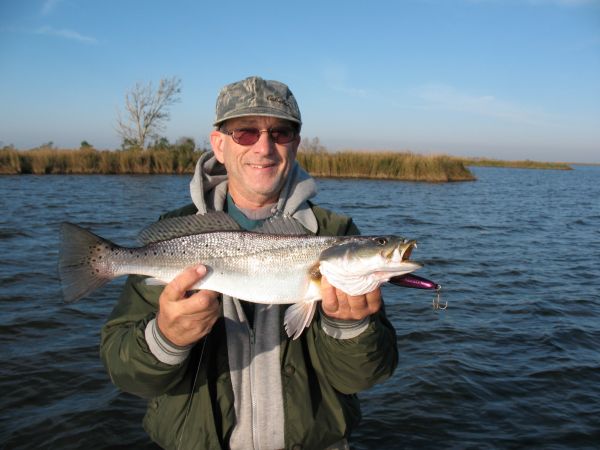
“That’s another thing I like to do,” Matherne explained. “These big fish are our breeding stock, and I really hate to keep anything over 3 pounds.
“The meat in the bigger fish isn’t as sweet anyway, so I like to catch and release the big ones — especially the females.”
Matherne also reminded anglers unused to topwater fishing not to jerk to set the hook.
“Never jerk it to set the hook, for two very important reasons,” he said. “First, if you jerk it, nine times out of 10 you’ll jerk it right out of his mouth and you’ll miss the fish.
“And second, when you jerk it and miss hooking the fish, that lure with all those treble hooks is going to come flying straight back to the boat toward you at high speed! A lot of people get hooks in them that way.”
Meanwhile, boats passed nearby, both going to and from the deeper waters of the sulphur mine.
“Most of those guys will anchor in 8 to 12 feet of water and fish the bottom with soft plastics on a ¼ or 3/8-ounce jig,” he said. “If you can get live minnows, that’s even better. And they’re catching a lot of fish in there right now, but all smaller fish. The smaller fish congregate in big numbers, maybe for the mutual body heat, and when you find them you’ll usually catch quite a few in one spot. And you usually pick up a red or two also.
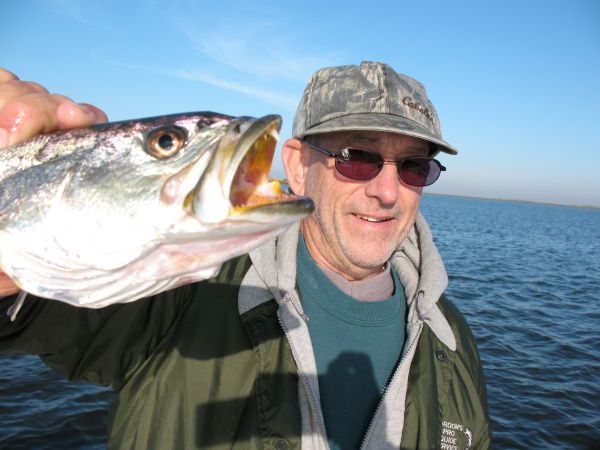
“Or if you want to target reds, you can fish with market bait along some of the pilings or structure, or up against the bank in deeper water. You’ll likely catch drum, sheepshead and reds like that.”
We caught a few more nice trout before calling it a day, and although I switched baits several times and managed to boat a few more decent fish, nothing matched the production of the purple demon color.
Odd, the way a particular color can out fish others some days.
“The one big drawback with this lure is the redfish love it, too,” Matherne said. “And I’ve lost a few of them to big reds that broke off my line.”
Lesson learned: Old dogs CAN learn new tricks, and once again I saw firsthand that not only can you catch trout in shallow water on cold days, but you can catch them on topwater baits.
Berra was right: It’s like déjà vu all over again.
Capt. Gordon Matherne can be reached at (985) 758-2824.
